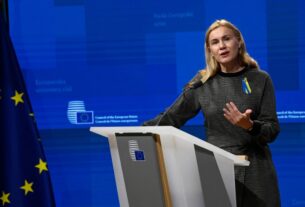Robin Millington is the CEO of Planet Tracker.
Simon Stiell, the new chief of the United Nations Framework Convention on Climate Change, has his work cut out for him. Indeed, there’s no magic wand to greening the global economy, but he does have the convening power to help bring policymakers, investors and financial institutions together in a more aligned way.
Investors and policymakers need to join forces to protect natural capital — i.e., the sum of the world’s stocks of natural assets from which we derive services like forestry, fishing, materials for building our homes and minerals to run our phones and electric vehicles.
From deploying mitigation and adaptation measures and easing the impact of environmental loss and damage to ensuring the green transition is fair for developing countries, good policy and good finance have to go hand in hand.
Take aquaculture, for example, an industry that supplies 49 percent of the global demand for fish, according to the U.N.’s Food and Agriculture Organization. Around 3 billion people rely on seafood as their primary protein. Meanwhile, aquafeed for the industry has an increasing reliance on soy, which is, in turn, driving deforestation. But innovative green bonds, issued by leading companies like Mowi and Grieg Seafood, are providing the capital needed to scale the use of more sustainable feed with novel ingredients, such as blackfly larvae and algae.
Such debt financing is clearly both feasible and desirable, and connecting the dots between industries and implementing supportive policies can have a positive impact.
In recent months, the world has become acutely aware of the value of nature. Food prices have risen dramatically, in part due to the conflict in Ukraine, but food shortages were already growing due to the impact of climate change. Russia’s war exponentially exacerbated the problem, however, creating a focal point for an issue that, unfortunately, had been brushed aside too often.
Now, food security and issues related to our food supply chains are rising to the top of national agendas.
This year alone, around 30 countries imposed food export restrictions, fearing that food insecurity could lead to civil unrest. And while bodies such as the U.N. demand that such protectionist measures are reduced to keep trade open and free, nature-dependent nations continue to put up trade barriers through bans, export licenses and/or export taxes, which lead to the disruption of supply chains.
Between 2010 and 2019, such nature-dependent exports accounted for 40 percent of total annual world trade, over a third of which originated from non-democratic regimes. In fact, 25 percent of renewable commodities — agricultural exports such as cereals, meat, dairy and seafood — were sourced from 90 non-democratic countries with an average annual export value of $602 billion.
This also raises the specter of the support we are giving, as a world community, to regimes that continue to drive deforestation, pollution and human rights violations, and that could easily cut off vital supplies at any time — as we have seen with Russia. Supply chain vulnerabilities are now clear to all.
So, what are financial institutions and policymakers to do, when a quarter or more of renewable commodities are at risk?
Firstly, a shift toward shorter supply chains and “friendly” jurisdictions, or “friend-shoring,” should be viewed with caution. Though these policies encourage secure local supply and can reinforce national food security, supply chains are much too complex to fully rein in. Moreover, in recent years, some moves toward deglobalization have been coupled with the rise of nationalism, in all its antidemocratic and xenophobic sentiment.
To reset the food system for a more sustainable, healthy and equitable food future, investors and policymakers should instead focus on supporting the transition toward a more sustainable global diet, while also working on ways to help soften the impact of supply chain shocks from climate, disease or geopolitics.
However, financial markets are also playing a significant role in backing industries that have a harmful impact on our natural capital. For example, Planet Tracker’s “Gran Chaco” research, which focuses on the risk of deforestation in the largest dry forest in South America, as well as the 12 soy traders that control 89 percent of soy exports from the Paraguayan and Argentinian Gran Chaco — revealed that in the policies of the 20 largest equity investors funding the “Deforestation Dozen,” only one of them explicitly recognizes the area as a high-risk biome.
Moving forward, the boom in environmental, social and governance data means that investors can now begin to understand the impact of their investments. Structured data gathering on natural capital issues and legislating for disclosure can help investors identify risks and opportunities, and it also lays the groundwork for better regulation in order to address specific issues.
This kind of enhanced accountability is what can turbocharge the transition toward not only a net zero future but also a just and nature-positive one at the pace required.
“We can do better, we must” — these were the parting words of outgoing U.N. climate chief Patricia Espinosa. And this means doing better at examining and acting on the interplay of issues, as we use what is left of the Earth’s natural capital. It also means boosting the way financial markets support policies — we need finance funneled into our solutions.
There was much positive momentum for this at COP 26 in Glasgow last year. Now, going into COP 27, we must accelerate that momentum.




